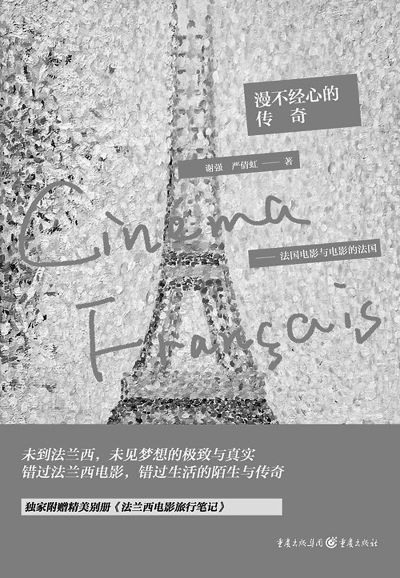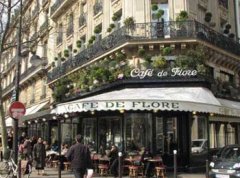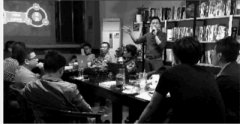Cafe and the movie "careless Legend"

The Seine, like an arc, winds its way through the city, dividing the whole of Paris into two parts, traditionally known as the left bank and the right bank. The Cabusina Avenue and Xiang Street mentioned earlier are located on the right bank.
So, let's start with the right bank.
In 1869, the Sisley family lived at No. 17 Huacheng at the foot of Montmartre Heights. Unlike downtown Paris, which overlooks the highlands, the neighborhood, which was assigned to Paris by Ottoman, who was then in charge of Paris's urban renovation in 1860, is almost still wild. In addition to providing cheap housing, artists, especially early Impressionist painters, had a fondness for the broad vision and romantic side of Montmartre Heights. At that time, academic painters, who belonged to the official art salon, mostly lived in the 17 boroughs to the west, which was the best middle-class residential area in Paris.
For Sisley, Montmartre has its commendable place: the studio he shares with Baziye is not far to the south. The Galboa Cafe, which often meets with Bazier, Manet, Renoir, Degas, Fontaine Latour, Monet, Pissarro, Cezanne and other future Impressionist painters, is not far from here. This group of people represent the avant-garde school formed on the eve of the Franco-Prussian War in 1870, even known as the "Galbois School". They are talking enthusiastically about the exhibition plan here. Manet is at the heart of the small group, and he discovered the cafe in 1863, when he used to go to the nearby store to buy paint. Writer Zola, critic Astruc, Diley and photographer Nadal also come here often. Zola wrote about the cafe in his novel works, using the name Bodkan Cafe. The cafe, originally located at 9 Clichy Avenue, Pigar Square, south of Montmartre, was known as the "everlasting mecca of bohemian culture and art". It was the spiritual symbol of Paris at that time, but now it is nowhere to be found.
Degas lived in his later years at 6 Clichy Avenue, opposite the Guilboa Cafe, and he was the last impressionist to live in Montmartre. I lived in Picasso on the 11th. Monet has a studio at 28 Pigar Street in the square. On the 16th, she lived in GeorgeSand, a female writer, who was in love with the pianist Chopin. They often meet at the Dutch romantic painter Ali Schaefer's house at 16 Shada Street, which has been changed into a "Museum of the Romantic Age" with a collection of relics and portraits of GeorgeSand in memory of the romantic novelist.
At the western end of Clichy Avenue, 130, near Clichy Square, lived in Picasso and Xiurah at 128 next door. Manet lives at 34 Batiniole Street, not far from Clichy Square. Clichy Square has also been the scene of many films, such as Truffaut's "four hundred strikes". 7 Clichy Street, near the square, is a three-hall avant-garde cinema, and the director of "the Wild Rose of Paris" (1986) asked Jacques Bennex as one of its founders. He and Luc Besson of the Metro (1985) and Leo Caracas of Newbridge (1991) were hailed as "three talents of French cinema", or "BBC", in the 1980s.
The area around Pigar and Clichy is a hedonist paradise, and the world-famous Moulin Rouge in Paris is at 82 Clichy Avenue. It was mentioned earlier that Renoir made a French Concan dance on the theme of Moulin Rouge (1955), while the musical Moulin Rouge (2001) directed by Buzz Ruhmann and starring Nicole Kidman also brought immortal fame to this famous nightclub.
On the left of the Moulin Rouge is Lubic Street, and up is the Montmartre Center. 15 Lubic Street is the double windmill cafe. Emily in Angel Love Beauty works as a waitress in this cafe. Now a signed photo of Audrey Tatu, who plays Emily, is posted on the wall of the cafe for visitors from all directions.
54 Lubic Street is the old home of Van Gogh and his brother Theo. Van Gogh came to Paris from the Netherlands in 1886 to join the only brother in the family who had a close relationship with him. Theo represented a large number of Impressionist works, and Van Gogh became acquainted with many Impressionist painters. In November 1887, Van Gogh and Gauguin met and became friends at first sight. The following year, the two spent 62 days together in Arles, a small town in southern Provence. They often paint portraits of each other in cafes, and Van Gogh often paints until the wee hours of the morning. In his paintings, there is a "Night Cafe" and a "Night Open-air Cafe". But the conflict of character and the difference of ideas between the two men led to one day in the dispute with Gauguin, Van Gogh fell into madness and drew a knife at each other, and finally cut off his ear.
In May 1889, under Theo's arrangement, the St. Remy Psychiatric Hospital was recuperated at the St. Remy Psychiatric Hospital up to 20 kilometers away. In May of the following year, Van Gogh came to Orville, a small town north of Paris, for medical treatment and lived in the attic of the Ravu Cafe opposite the City Hall. He was still diligent in painting. Seventy days later, when he was out painting, he shot himself and died two days later. In his will to Theo, he wrote: "I believe that after my death, there will be an exhibition of my paintings in the cafe." Unfortunately, Theo also died of illness six months later. In 1996, 16 years after Van Gogh's death, Ravu Cafe finally held a two-month exhibition of Van Gogh paintings. Now the cafe has changed its name to Van Gogh House.
From "careless Legend."
By Xie Qiang and Yan Qianhong
Important Notice :
前街咖啡 FrontStreet Coffee has moved to new addredd:
FrontStreet Coffee Address: 315,Donghua East Road,GuangZhou
Tel:020 38364473
- Prev

Stroll through the Cafe Cafe in Paris to enlighten the art
Nurturing social thoughts and enlightening artistic inspiration in Paris, the French capital, it is not difficult to find historical sites and cultural landmarks. Perhaps the unattractive cafe around you used to be frequented by Picasso, Dali, Monet, Chopin, Voltaire and even Napoleon. Wandering among the celebrity cafes in Paris, France's brilliant culture, art and history seem within reach. Old
- Next

Spend the money of a cup of coffee to create a dream of starting a business?
On the evening of April 2, an actual salon was being held on the theme of how the catering industry should embrace the Internet. Want to start a business? As long as you order a cup of coffee, you can get a simple office space, find the right business partner, get business guidance from experts, and even win the favor of investors. The new mass innovation space model, which takes the cafe as the carrier and provides entrepreneurial services for entrepreneurs, is in Beijing and so on.
Related
- How did the Salvadoran coffee industry develop in Central America?
- What exactly does the golden cup extraction of coffee mean?
- The Origin of Coffee flower
- [2023 Starbucks World Earth Day] there are more meaningful things besides free Starbucks coffee!
- What kind of coffee is there in Spain? 9 Flavors of Spanish Coffee
- Aromatic African coffee| Kenya's coffee culture and historical production area
- Liberica Coffee Bean knowledge: the characteristics of Liberian Coffee beans of the three original species of Coffee beans
- The origin and formula of Spanish latte introduces the taste characteristics of Bombon coffee in Valencia, Spain.
- How to adjust the solution of over-extracted coffee
- What is the tasting period of coffee beans? What is the period of coffee and beans? How should coffee wake up and raise beans?

